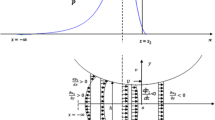Abstract
IT is now well known that the lubrication at such nominal line contacts as are found in roller races and between gear teeth is hydrodynamic in character. It is also known that this lubrication possesses peculiar features not found in journal bearings and which arise from the high pressure—a pressure, for example, of tens of tons per square inch as compared with 100 lb. in.−2. Because of the pressure the surfaces are deformed, in general elastically, and in addition within the pressure zone the oil acquires a much higher viscosity than it normally possesses; the viscosity might be greater by a thousand-fold. These circumstances have excited much inquiry as to the shape in cross-section of the hydrodynamic film. This communication reports an experimental measurement of that shape.
Similar content being viewed by others
References
Crook, A. W., Phil. Trans. Roy. Soc., A, 250, 387 (1958).
Grubin, A. N., Central Scientific Research Institute for Technology and Mechanical Engineering, Book No. 30 (Moscow, 1949). (D.S.I.R. Translation No. 337.)
Dowson, D., and Higginson, G. R., J. Mech. Eng. Sci., 1, 6 (1959); 2, 188 (1960).
Archard, G. D., Gair, F., and Hirst, W., Proc. Roy. Soc. (in the press).
Author information
Authors and Affiliations
Rights and permissions
About this article
Cite this article
CROOK, A. Elastohydrodynamic Lubrication of Rollers. Nature 190, 1182–1183 (1961). https://doi.org/10.1038/1901182a0
Issue Date:
DOI: https://doi.org/10.1038/1901182a0
- Springer Nature Limited
This article is cited by
-
An Elastohydrodynamic Lubrication Experiment
Nature (1963)
-
Lubrication in Synovial Joints
Nature (1963)





